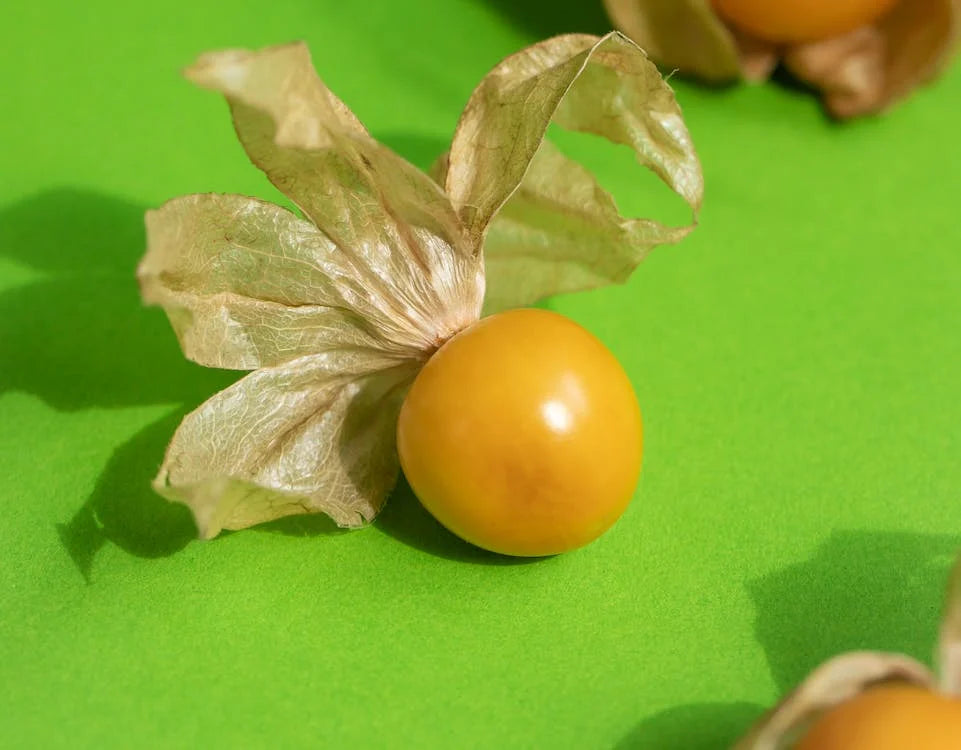
We’ve been asked where we get our blog ideas. Most of the time we’re just exploring seasonal garden topics and working to give our readers useful information, but occasionally there’s an interesting story behind a blog topic—this is one of those! Last week we published a blog about what to plant in the fall garden, and we mentioned Chinese lantern as a possibility. Well, we made a mistake and we’d like to correct it now. We identified Chinese lantern as Physalis alkekengi. As it turns out, P. alkekengi is more properly referred to as Alkekengi officinarum, so we’ll make that correction in the original blog. This led to another discussion here at Gardzen: some of us thought that Chinese lantern was an edible and tasty plant, unlike what we had read about Alkekengi officinarum. Well, as it turns out we were talking about two different plants. The edible plant sometimes referred to a Chinese lantern is the closely related Physalis peruviana and Physalis pruinosa, better known to some of us as “ground cherry.” A. officinarum and ground cherry are both edible when the fruit are fully ripe, but leaves, stems and unripe fruit can be toxic to both people and pets.
Once we figured out all that confusion—we might actually still be a little confused—we decided to write a blog about ground cherry (P. peruviana and P. pruinosa) which is a tasty and useful garden plant. So, thanks for bearing with us, please forgive the mixup, and let’s dig in!
What is Ground Cherry?
Gound cherry is a member of the nightshade family, and it grows in a manner similar to its cousin the tomatillo. After the flower is pollinated, a papery husk forms and the fruit grows inside of that. It’s a really interesting mechanism and fun to observe—if you’re very gentle you can squeeze the husk a bit and feel how bit the fruit has gotten inside. Once again, the stems, leaves, and unripe fruits of this plant can be toxic to both people and animals. Before anyone panics, many garden plants have similar issues—all non-fruit parts of the tomato can be toxic, as are all parts of the potato plant but the tubers. Don’t let his put you off growing ground cherry, but just be mindful about where you position the plant in your garden and who might have access to it.
The ripe fruits have an interesting flavor; they’re tart like cherry tomatos but with an almost tropical fruit character—it’s like a blend of mango and pineapple as well. This makes is useful as an ingredient in both sweet and savory dishes. You can add it to a salsa or make jams and preserves with the same fruit!

Growing Ground Cherry
Since it’s a relative of tomatillo and (more distantly) tomatoes, many of you will already be familiar with the methods for growing ground cherry. Like those popular garden plants, ground cherry should be started indoors six to eight weeks before the last frost date in the spring. Seeds should be planted in seed trays filled with a good starting mix, about a ¼ inch/6-7mm deep and roughly 12 inches/30cm apart. They like to be kept warm, with moist but not soaked soil and plenty of light. Transplant them outside about the same time you would tomatoes or tomatillos.
Ground cherry likes full sun, so find a spot in your garden space that gets good light. They prefer a rich, well drained soil, and require about one inch/2.5cm of water a week under temperate conditiosn, but may need more when the weather gets hot. Ground cherries put out deep roots, so they are relatively resistant to heat and drought but good watering helps ensures plentiful blooms and a good harvest. A good layre of mulch can help keep the soil healthy and conserve water, so don’t forget that step!
For the patio and container gardeners out there: ground cherry do well in containers, but like tomatoes they need a rather large one—5 gallons/20liters is a good size per plant. They can make a very nice addition to a container garden, as they’re visually striking plants in addition to being tasty!

When to Harvest Ground Cherry
So, if the unripe fruit aren’t edible, how do you know when the fruit are ripe. Fortunately, there’s a clue in the name—ground cherry fruits fall to the ground when they’re ready for harvest. When the husk are fully dried out and the fruit has fallen to the ground, the ground cherry is ready to eat. You can enjoy them fresh, turn them into salsas, jams, jellies, or other preserves, or keep them in a cool dry place for a few weeks. The fresh fruit last a good long time if the outer husk remain intact.
So, after all that confusion, we’ve learned a lot more about both ground cherry and Alkekengi officinarum, and we hope you have too! Both of these plants are beautiful and potentially useful, we just have to understand what they are and work with them to use them appropriately in our gardens. If you have any stories, tips, or other feedback about these garden plants, please reach out! Gardzen is all about community and we love to hear from you!

Leave a comment